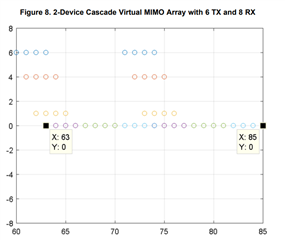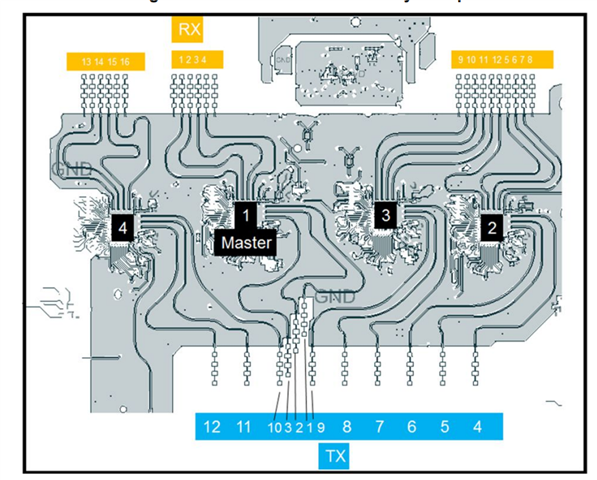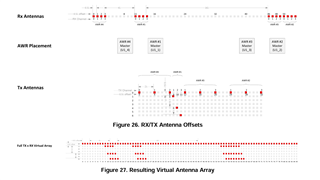Tool/software:
If the AWR2243 cascaded radar only uses the two radars (AWR1 and AWR4), does this mean the virtual array in the vertical direction will have 7 antennas? What will the virtual array look like?
This thread has been locked.
If you have a related question, please click the "Ask a related question" button in the top right corner. The newly created question will be automatically linked to this question.
Tool/software:
If the AWR2243 cascaded radar only uses the two radars (AWR1 and AWR4), does this mean the virtual array in the vertical direction will have 7 antennas? What will the virtual array look like?
Hi Henrry,
You can check section 3.1 Antenna Configuration of the following document - Imaging Radar Using Cascaded mmWave Sensor Reference Design (Rev. A).
Here is a screenshot of the virtual antenna array when two devices (Device 1 and Device 4) are used -

Regards,
Samhitha
Hi Samhitha,
I saw the reference you provided, but I’m still confused. The image shows only 4 vertical antennas? Considering the TX layout of Device 1, shouldn’t it actually be 7? The number of vertical antennas is 7, and the number of horizontal antennas is 23.Is that accurate ?Also, is it no longer feasible to simply use the FFT method to calculate the elevation and azimuth angles?
Thanks,
Henrry
Hi Henrry,
The image shows only 4 vertical antennas? Considering the TX layout of Device 1, shouldn’t it actually be 7? The number of vertical antennas is 7, and the number of horizontal antennas is 23.Is that accurate ?
I didn't understand your question. Which 4 or 7 vertical antennas are you referring to? There are 3 Tx in azimuth plane and 3 Tx in elevation.
Also, is it no longer feasible to simply use the FFT method to calculate the elevation and azimuth angles?
You can refer to MATLAB scripts at C:\ti\mmwave_studio_03_00_00_14\mmWaveStudio\MatlabExamples for details regarding post processing.
Regards,
Samhitha
Hi Henrry,
In the below screenshot, you can clearly see that Tx1, Tx2, Tx3 are the elevation antennas. And all these three elevation antennas are not in the same plane.

If you draw a virtual antenna array, it looks like the one that I shared in previous reply.
The virtual antenna array formed with the Tx of device 4 is only in azimuth direction. Each Tx antenna of Device 1 are in different planes and 8 elevation virtual antennas are available in each plane.
I mean, in the case of MIMO virtual arrays, how many elements do Device 1 and Device 4 provide in the elevation direction?4 or 7 ?
I do not understand how you get 4 or 7 antennas in elevation direction.
Regards,
Samhitha


Hi Samhitha,
Thank you for your patience. Since there are overlapping antennas in the vertical direction, the elevation angle resolution is equivalent to that achieved with 7 antennas.I'm not sure if this understanding is correct.
Thanks,
Henrry
Hi Henrry,
There is no overlapping antenna in elevation direction. There is only one overlapping antenna in azimuth direction.
In case of 2-chip cascade formed out of Device 1 and Device 4, there are 3 Azimuth Tx and 3 Elevation Tx.
Number of azimuth virtual antennas should be 8Rx * 3Tx = 24 virtual antennas. Since there is one overlapping antenna, final azimuth virtual antennas is 23.
You can check section 3.1 Antenna Configuration of the following document - Imaging Radar Using Cascaded mmWave Sensor Reference Design (Rev. A).
Please check the previous reply where the screenshot is also attached. There is no overlapping elevation antennas.
Since there are overlapping antennas in the vertical direction, the elevation angle resolution is equivalent to that achieved with 7 antennas.I'm not sure if this understanding is correct.
The description in the user guide says there are overlapping antennas in azimuth direction (not elevation). In 2D plane, azimuth antennas are the one depicted in horizontal plane. Also the description that you are referring to is for 4-chip cascade.
Refer to the following documents for detailed understanding about virtual antenna arrays -
Regards,
Samhitha